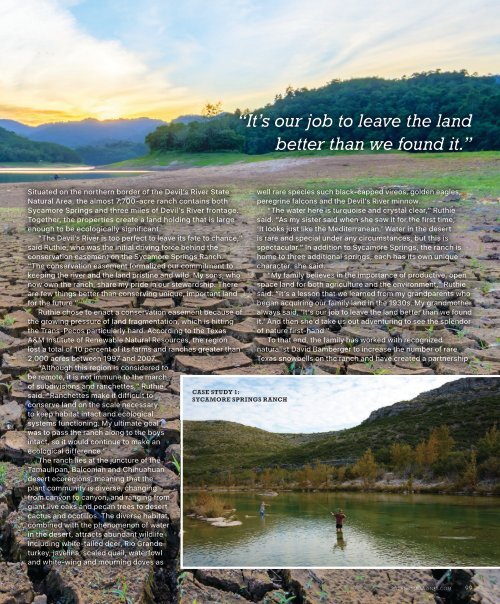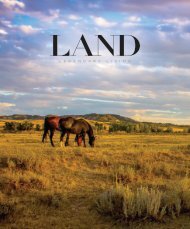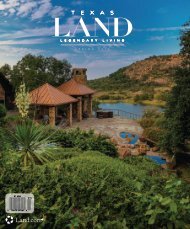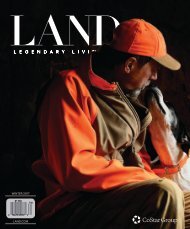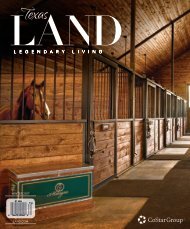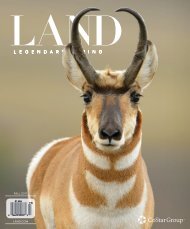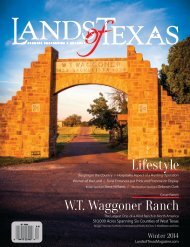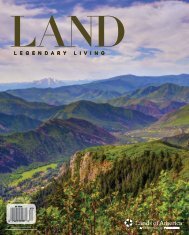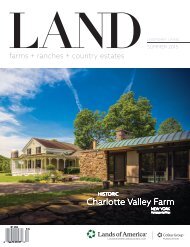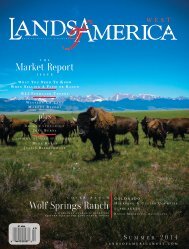You also want an ePaper? Increase the reach of your titles
YUMPU automatically turns print PDFs into web optimized ePapers that Google loves.
“It’s our job to leave the land<br />
better than we found it.”<br />
Situated on the northern border of the Devil’s River State<br />
Natural Area, the almost 7,700-acre ranch contains both<br />
Sycamore Springs and three miles of Devil’s River frontage.<br />
Together, the properties create a land holding that is large<br />
enough to be ecologically significant.<br />
“The Devil’s River is too perfect to leave its fate to chance,”<br />
said Ruthie, who was the initial driving force behind the<br />
conservation easement on the Sycamore Springs Ranch.<br />
“The conservation easement formalized our commitment to<br />
keeping the river and the land pristine and wild. My sons, who<br />
now own the ranch, share my pride in our stewardship. There<br />
are few things better than conserving unique, important land<br />
for the future.”<br />
Ruthie chose to enact a conservation easement because of<br />
the growing pressure of land fragmentation, which is hitting<br />
the Trans-Pecos particularly hard. According to the Texas<br />
A&M Institute of Renewable Natural Resources, the region<br />
lost a total of 10 percent of its farms and ranches greater than<br />
2,000 acres between 1997 and 2007.<br />
“Although this region is considered to<br />
be remote, it is not immune to the march<br />
of subdivisions and ranchettes,” Ruthie<br />
said. “Ranchettes make it difficult to<br />
conserve land on the scale necessary<br />
to keep habitat intact and ecological<br />
systems functioning. My ultimate goal<br />
was to pass the ranch along to the boys<br />
intact, so it would continue to make an<br />
ecological difference.”<br />
The ranch lies at the juncture of the<br />
Tamaulipan, Balconian and Chihuahuan<br />
desert ecoregions, meaning that the<br />
plant community is diverse, changing<br />
from canyon to canyon, and ranging from<br />
giant live oaks and pecan trees to desert<br />
cactus and ocotillos. The diverse habitat,<br />
combined with the phenomenon of water<br />
in the desert, attracts abundant wildlife<br />
including white-tailed deer, Rio Grande<br />
turkey, javelina, scaled quail, waterfowl<br />
and white-wing and mourning doves as<br />
CASE STUDY 1:<br />
SYCAMORE SPRINGS RANCH<br />
well rare species such black-capped vireos, golden eagles,<br />
peregrine falcons and the Devil’s River minnow.<br />
“The water here is turquoise and crystal clear,” Ruthie<br />
said. “As my sister said when she saw it for the first time,<br />
‘It looks just like the Mediterranean.’ Water in the desert<br />
is rare and special under any circumstances, but this is<br />
spectacular.” In addition to Sycamore Springs, the ranch is<br />
home to three additional springs, each has its own unique<br />
character, she said.<br />
“My family believes in the importance of productive, open<br />
space land for both agriculture and the environment,” Ruthie<br />
said. “It’s a lesson that we learned from my grandparents who<br />
began acquiring our family land in the 1930s. My grandmother<br />
always said, ‘It’s our job to leave the land better than we found<br />
it.’ And then she’d take us out adventuring to see the splendor<br />
of nature first-hand.”<br />
To that end, the family has worked with recognized<br />
naturalist David Bamberger to increase the number of rare<br />
Texas snowbells on the ranch and have created a partnership<br />
LANDMAGAZINES.COM<br />
99


